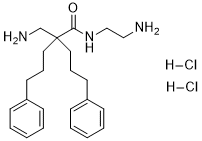| Cas No.: | 1398051-86-9 |
| Chemical Name: | N-(2-Aminoethyl)-α-(aminomethyl)-α-(3-phenylpropyl)benzenepentanamide Conjugate Acid (1:2) |
| Synonyms: | N-(2-aminoethyl)-2-(aminomethyl)-5-phenyl-2-(3-phenylpropyl)pentanamide dihydrochloride;LTX-401 HCl |
| SMILES: | Cl.Cl.O=C(C(CN)(CCCC1C=CC=CC=1)CCCC1C=CC=CC=1)NCCN |
| Formula: | C23H35Cl2N3O |
| M.Wt: | 440.449504137039 |
| Purity: | >98% |
| Sotrage: | 2 years -20°C Powder, 2 weeks 4°C in DMSO, 6 months -80°C in DMSO |
| Description: | LTX-401 (LTX401) is an oncolytic amino acid derivative with potential immunogenic properties, selectively destroys the structure of the Golgi apparatus; selectively enriched in the Golgi rather than in mitochondria or in the cytosol, induced all major hallmarks of immunogenic cell death detectable with biosensor cell lines including calreticulin exposure, ATP release, HMGB1 exodus and a type-1 interferon response; induces DAMP release in melanoma cells and causes complete regression of B16 melanoma. |

 To enhance service speed and avoid tariff delays, we've opened a US warehouse. All US orders ship directly from our US facility.
To enhance service speed and avoid tariff delays, we've opened a US warehouse. All US orders ship directly from our US facility.




















